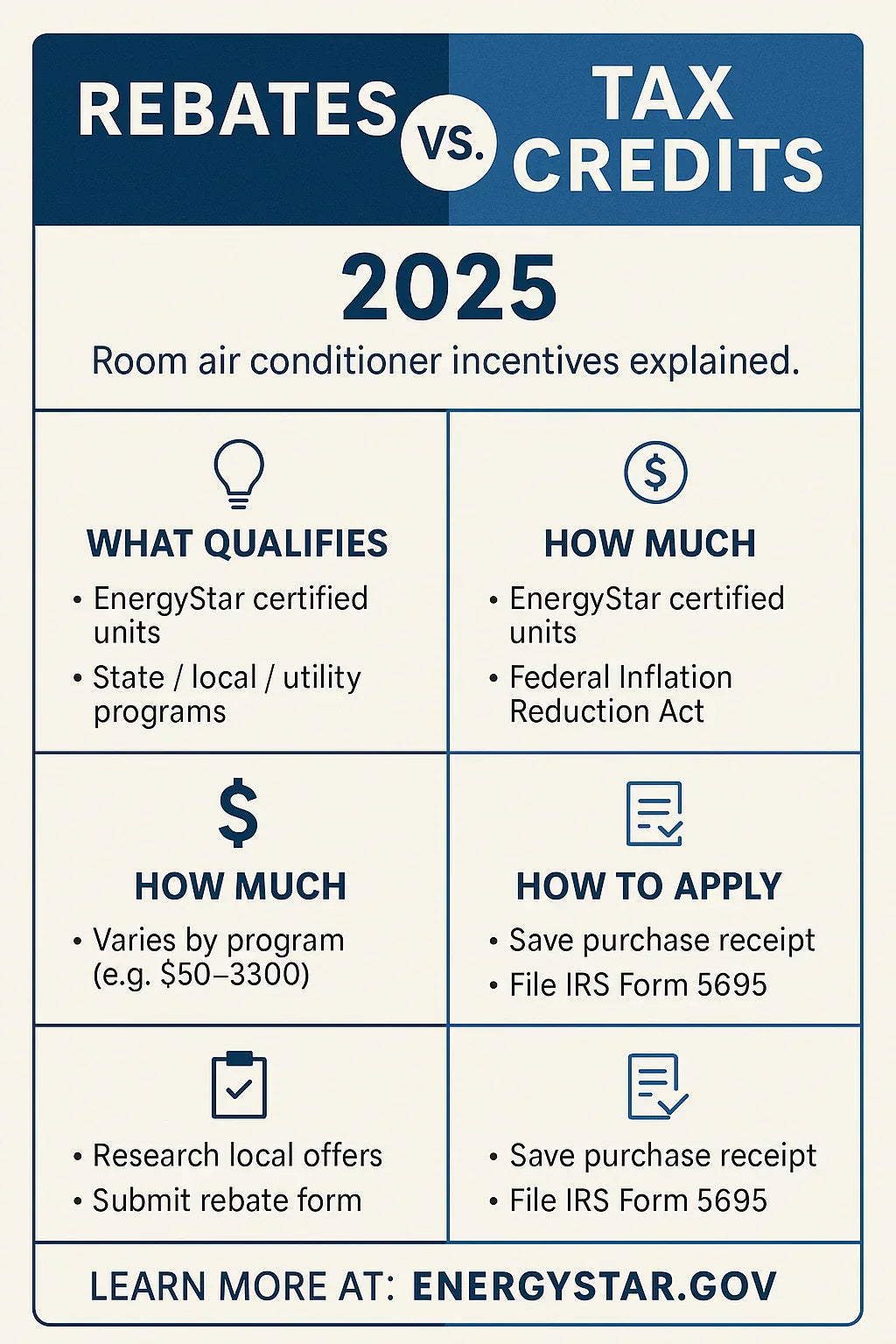Upgrading your heating and cooling system can feel like a big expense—but here’s some good news: in 2025, energy rebates and tax credits are still available to help homeowners save money. The catch? Not all Amana, GE, or Hotpoint units qualify.
If you’re considering one of these brands, this guide will walk you through which models qualify, what programs apply, and how to claim your rebates or credits.
🌍 Why Incentives Exist
The U.S. government and many states want to encourage homeowners to choose energy-efficient appliances. That’s why:
-
The Inflation Reduction Act (IRA) extended tax credits through 2032.
-
State utility companies often run rebate programs for EnergyStar-certified units.
-
The goal is to lower greenhouse gas emissions and reduce energy bills for consumers.
👉 Learn more about the Inflation Reduction Act energy credits.
🏛️ Federal Tax Credits in 2025
Under the IRA, homeowners can claim the Energy Efficient Home Improvement Credit (25C):
-
Covers 30% of the cost of qualifying energy-efficient equipment.
-
Annual cap: $1,200 for most improvements.
-
To qualify, the unit must be EnergyStar certified.
💡 This means only EnergyStar-certified Amana, GE, or Hotpoint units qualify—basic models without certification do not.
👉 Details available at EnergyStar’s tax credit page.
🏢 State & Utility Rebates
Beyond federal tax credits, many states and utilities offer cash rebates:
-
Rebates typically range from $50–$300 per unit.
-
Some utilities offer higher incentives for heat pump units.
-
Rebates often apply to multi-family housing upgrades—great news for landlords.
👉 Use the DSIRE database to check your state’s programs.
⭐ Why EnergyStar Certification Matters
EnergyStar is the gold standard for qualifying equipment:
-
To earn certification, units must meet strict efficiency requirements for EER (Energy Efficiency Ratio) and CEER (Combined EER).
-
EnergyStar-certified units use 10–15% less energy than standard models.
-
Rebates and credits almost always require EnergyStar certification.
👉 See the EnergyStar certified room air conditioners list.
🔴 Amana Units: Do They Qualify?
Amana is known for durability and warranties—but how do they fare for incentives?
-
Many Amana PTAC and wall units are EnergyStar certified, especially newer heat pump models.
-
Eligible for both federal tax credits and many state rebates.
-
Units with supplemental electric heat may not always qualify unless listed on EnergyStar’s site.
💡 If rebates matter to you, choose an Amana unit clearly marked EnergyStar.
👉 Verify your unit at Amana HVAC Official Site.
🔵 GE Units: Do They Qualify?
GE has long been a leader in energy-efficient wall units—especially their Zoneline series.
-
Many GE units meet or exceed EnergyStar standards.
-
Known for high CEER ratings, which translate to lower energy bills.
-
Strong candidates for both federal and state rebates.
👉 Check eligible models at GE Zoneline PTAC.
⚪ Hotpoint Units: Do They Qualify?
Hotpoint is the most budget-friendly brand, but fewer models qualify for rebates.
-
Most Hotpoint units are basic, entry-level systems without EnergyStar certification.
-
Limited eligibility for rebates or credits.
-
Best option if you prioritize low upfront cost over long-term efficiency.
📑 How to Apply for Rebates or Tax Credits
Here’s the process step by step:
-
Choose a qualifying unit
-
Check the EnergyStar database before you buy.
-
-
Save all receipts
-
Equipment and installation costs may be eligible.
-
-
Download and file IRS Form 5695 for federal credits.
-
Check your utility company’s website for rebate applications.
-
Submit proof of purchase—often requires the EnergyStar model number.
💡 Tip: Apply quickly—some rebate funds run out mid-year.
📝 Samantha’s Cost-Savings Example
When I installed my GE wall unit last year:
-
Unit cost: $1,200
-
EnergyStar rebate from utility: $150
-
Federal tax credit: $360 (30% of cost)
-
Total savings: $510
That’s nearly half a year of electricity bills covered just for choosing an efficient unit.
📊 Brand-by-Brand Summary
| Brand | EnergyStar Models | Federal Tax Credit Eligible | State/Utility Rebates | Best For |
|---|---|---|---|---|
| Amana | Many | ✅ Yes | ✅ Yes | Long-term reliability + savings |
| GE | Many | ✅ Yes | ✅ Yes | Efficiency + tech features |
| Hotpoint | Few | ⚠️ Limited | ⚠️ Limited | Lowest upfront cost |
⚠️ Common Mistakes to Avoid
-
Buying a non-EnergyStar unit → No rebates, no tax credits.
-
Not checking local programs → Many rebates are regional.
-
Forgetting to file Form 5695 → Don’t miss your tax credit!
-
Ignoring deadlines → Rebates often close early.
📝 Samantha’s Final Thoughts
If saving money is one of your goals in 2025, here’s the bottom line:
-
Amana and GE are the clear winners for rebate and tax credit eligibility.
-
Hotpoint is cheaper upfront, but don’t expect the same level of incentives.
-
Always check EnergyStar certification before buying—it’s the key to unlocking both rebates and federal tax credits.
The best part? Choosing an EnergyStar-certified unit doesn’t just save money at checkout—it keeps paying you back every month on your utility bills.
In the next topic we will know more about: Noise, Space & Design: Will These Units Fit in Your Home Setup?







